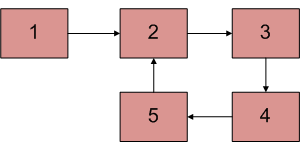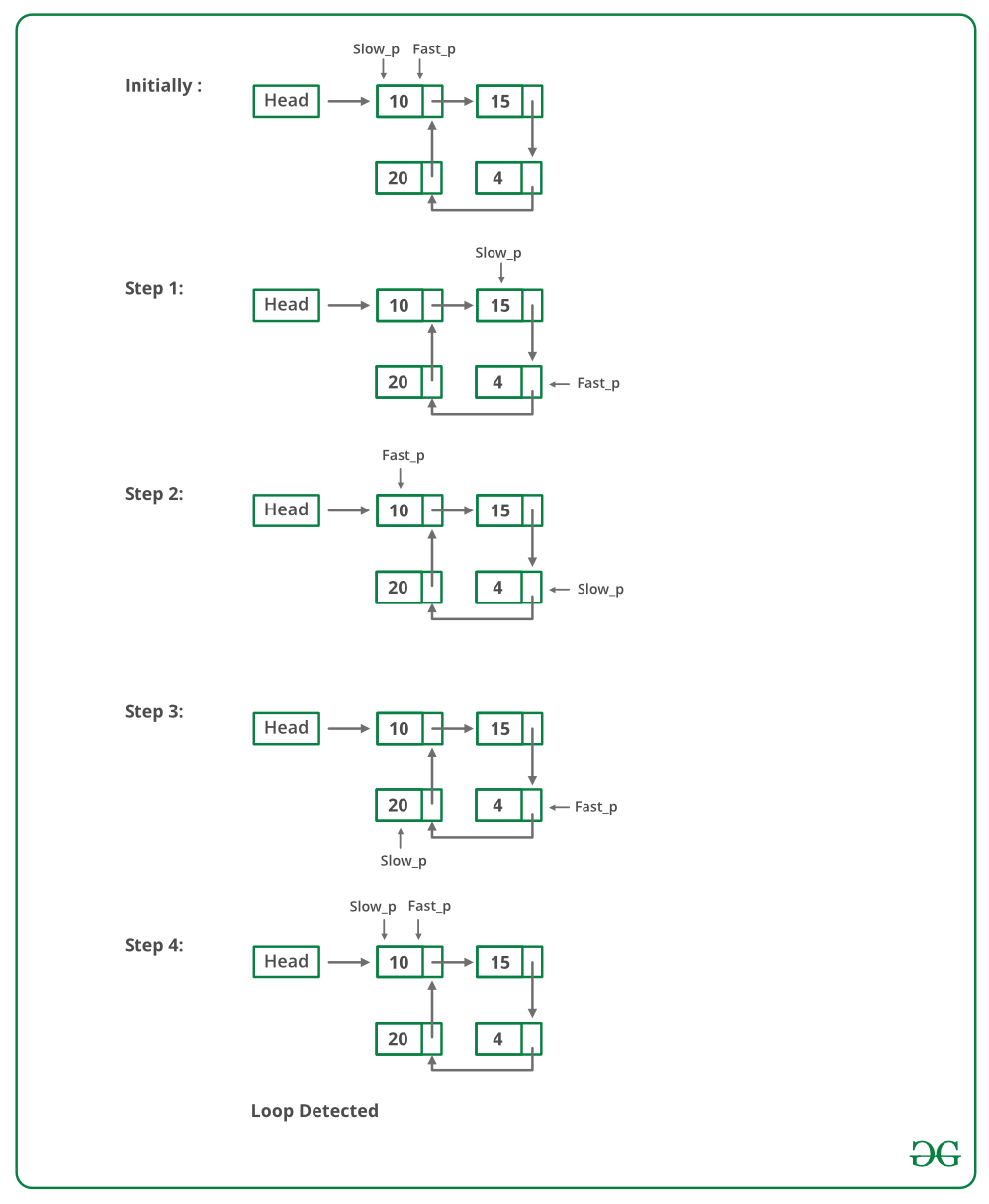C++程序 检测链表中的循环
给定一个链表,检查它是否存在循环。下面的图示展示了带有循环的链表。

以下是不同的实现方法。
解法 1:哈希方法:
逐一遍历列表,将节点地址放入哈希表中。若到达 NULL 则返回 false,若当前节点的下一个指向哈希表中已经存储的任意一个节点,则返回 true。
// C++ program to detect loop in a linked list
#include <bits/stdc++.h>
using namespace std;
/* Link list node */
struct Node {
int data;
struct Node* next;
};
void push(struct Node** head_ref, int new_data)
{
/* allocate node */
struct Node* new_node = new Node;
/* put in the data */
new_node->data = new_data;
/* link the old list off the new node */
new_node->next = (*head_ref);
/* move the head to point to the new node */
(*head_ref) = new_node;
}
// Returns true if there is a loop in linked list
// else returns false.
bool detectLoop(struct Node* h)
{
unordered_set<Node*> s;
while (h != NULL) {
// If this node is already present
// in hashmap it means there is a cycle
// (Because you we encountering the
// node for the second time).
if (s.find(h) != s.end())
return true;
// If we are seeing the node for
// the first time, insert it in hash
s.insert(h);
h = h->next;
}
return false;
}
/* Driver program to test above function*/
int main()
{
/* Start with the empty list */
struct Node* head = NULL;
push(&head, 20);
push(&head, 4);
push(&head, 15);
push(&head, 10);
/* Create a loop for testing */
head->next->next->next->next = head;
if (detectLoop(head))
cout << "Loop found";
else
cout << "No Loop";
return 0;
}
// This code is contributed by Geetanjali```
输出
Loop found
复杂度分析:
- 时间复杂度: O(n)。 只需要一次遍历循环。
- 辅助空间: O(n)。 n 是哈希表所需的空间。
解法 2: 可以通过修改链表数据结构来解决此问题,不需要使用哈希表。
做法: 此解决方法需要修改基本链表数据结构。
- 对每个节点,添加一个已访问标记。
- 遍历链表并标记已访问的节点。
- 如果再次遇到已标记的节点,则存在循环。这种解法的时间复杂度为 O(n),但需要在每个节点上添加额外信息。
- 这种方法的一种变体,不需要修改基本数据结构,可以通过哈希表实现。只需在哈希表中存储已访问节点的地址,并且如果看到哈希表中已经存在的地址,则存在循环。
// C++程序:检测链表中的循环
#include
using namespace std;
/* 链表节点 */
struct Node{
int data;
struct Node* next;
int flag;
};
void push(struct Node** head_ref, int new_data){
/* 分配节点 */
struct Node* new_node = new Node;
/* 存储数据 */
new_node->data = new_data;
new_node->flag = 0;
/* 将旧链表连接到新节点上 */
new_node->next = (*head_ref);
/* 将头指针移向新节点 */
(*head_ref) = new_node;
}
// 如果链表中存在循环,返回true;否则返回false
bool detectLoop(struct Node* h){
while (h != NULL){
// 如果遇到已经遍历过的节点
// 这意味着链表中有一个循环
// (因为你第二次遇到了节点)。
if (h->flag == 1)
return true;
// 如果我们第一次遇到这个节点,则将其标记为1
h->flag = 1;
h = h->next;
}
return false;
}
/* 主函数用于测试上述函数*/
int main(){
/* 开始为空链表 */
struct Node* head = NULL;
push(&head, 20);
push(&head, 4);
push(&head, 15);
push(&head, 10);
/* 创建一个循环来测试 */
head->next->next->next->next = head;
if (detectLoop(head))
cout << "Loop found";
else
cout << "No Loop";
return 0;
}
// 本代码由Geetanjali贡献```
输出
Loop found
复杂度分析:
- 时间复杂度: O (n)。 仅需要一次遍历循环。
- 辅助空间: O (1)。 不需要额外的空间。
解决方案3:Floyd的循环查找算法
方法: 这是最快的方法,如下所述:
- 使用两个指针遍历链表。
- 将一个指针(slow_p)移动一步,另一个指针(fast_p)移动两步。
- 如果这些指针在同一节点相遇,则存在循环。如果指针不相遇,则链表没有循环。
以下图像显示了代码中的detectloop函数的工作方式:

Floyd循环查找算法的实现:
// C++程序检测链表中的循环
#include <bits/stdc++.h>
using namespace std;
/*链表节点*/
class Node {
public:
int data;
Node* next;
};
void push(Node** head_ref, int new_data)
{
/*分配节点*/
Node* new_node = new Node();
/*放入数据*/
new_node->data = new_data;
/*将旧列表连接到新节点*/
new_node->next = (*head_ref);
/*将头移动到新节点*/
(*head_ref) = new_node;
}
int detectLoop(Node* list)
{
Node *slow_p = list, *fast_p = list;
while (slow_p && fast_p && fast_p->next) {
slow_p = slow_p->next;
fast_p = fast_p->next->next;
if (slow_p == fast_p) {
return 1;
}
}
return 0;
}
/*主方法*/
int main()
{
/*从空列表开始*/
Node* head = NULL;
push(&head, 20);
push(&head, 4);
push(&head, 15);
push(&head, 10);
/*创建用于测试的循环*/
head->next->next->next->next = head;
if (detectLoop(head))
cout << "循环存在";
else
cout << "没有循环";
return 0;
}
// 本代码由rathbhupendra提供```
输出
循环存在
时间/空间复杂度分析:
- 时间复杂度: O(n)。 只需要一次遍历循环。
- 空间复杂度: O(1)。 不需要额外空间。
解决方案4:标记访问但不修改链接列表结构的节点
在此方法中,创建一个临时节点。将要遍历的每个节点的下一个指针指向此临时节点。通过这种方式,我们使用节点的下一个指针作为标志来指示节点是否已遍历。检查每个节点以查看下一个指向临时节点还是不指向。对于循环的第一个节点,在第二次遍历它时,这个条件将为真,因此我们发现存在循环。如果遇到指向空的节点,则不存在循环。
以下是上述方法的实现:
// C++程序返回循环链表的第一个节点
#include
using namespace std;
struct Node{
int key;
struct Node* next;
};
Node* newNode(int key){
Node* temp = new Node;
temp->key = key;
temp->next = NULL;
return temp;
}
// 一个实用函数,用于打印链表
void printList(Node* head){
while (head != NULL){
cout << head->key << " ";
head = head->next;
}
cout << endl;
}
// 检测在可能包含循环的链表中的第一个节点的函数
bool detectLoop(Node* head){
// 创建一个临时节点
Node* temp = new Node;
while (head != NULL){
// 这个条件是为了不存在循环的情况
if (head->next == NULL){
return false;
}
// 检查下一个是否已经指向temp
if (head->next == temp){
return true;
}
// 存储指向下一个节点的指针,以便在下一步中访问它
Node* nex = head->next;
// 将下一个指向temp
head->next = temp;
// 访问列表中的下一个节点
head = nex;
}
return false;
}
/* 测试上面的函数的驱动程序*/
int main(){
Node* head = newNode(1);
head->next = newNode(2);
head->next->next = newNode(3);
head->next->next->next = newNode(4);
head->next->next->next->next = newNode(5);
/* 创建一个用于测试的循环(5指向3)*/
head->next->next->next->next->next = head->next->next;
bool found = detectLoop(head);
if (found){
cout << "Loop Found";
}
else{
cout << "No Loop";
}
return 0;
}
输出
Loop Found
复杂度分析:
- 时间复杂度: O(n)。 只需要一次遍历循环。
- 辅助空间: O(1)。 不需要额外的空间。
解决方案5:存储长度
在此方法中,创建两个指针,第一个始终指向头,第二个始终指向末尾。每次最后一个指针移动时,我们计算第一个和最后一个之间的节点数,并检查当前节点数是否大于先前节点数,如果是,则进行下一步移动最后一个指针,否则它意味着我们已经到达了循环的结尾,因此返回相应的输出。
//C++程序,用于返回循环的第一个节点
#include
using namespace std;
struct Node {
int key;
struct Node* next;
};
Node* newNode(int key)
{
Node* temp = new Node;
temp->key = key;
temp->next = NULL;
return temp;
}
//打印链表的实用函数
void printList(Node* head)
{
while (head != NULL) {
cout << head->key << " ";
head = head->next;
}
cout << endl;
}
/*每次返回第一个和最后一个节点之间的距离*/
int distance(Node* first, Node* last)
{
/*计算第一个节点和最后一个节点之间的节点数*/
int counter = 0;
Node* curr;
curr = first;
while (curr != last) {
counter += 1;
curr = curr->next;
}
return counter + 1;
}
//检测可能包含循环的链表中的第一个循环节点的功能
bool detectLoop(Node* head)
{
//创建一个临时节点
Node* temp = new Node;
Node *first, *last;
/*first始终指向head*/
first = head;
/*last指针最初指向head*/
last = head;
/*current_length存储当前
* first和last之间的节点数*/
int current_length = 0;
/*prev_length存储上一个
* first和last之间的节点数*/
int prev_length = -1;
while (current_length > prev_length && last != NULL) {
//将prev_length设置为current_length,然后更新当前长度
prev_length = current_length;
//计算距离
current_length = distance(first, last);
//将最后一个节点指向下一个节点
last = last->next;
}
if (last == NULL) {
return false;
}
else {
return true;
}
}
/*测试上述功能的驱动程序*/
int main()
{
Node* head = newNode(1);
head->next = newNode(2);
head->next->next = newNode(3);
head->next->next->next = newNode(4);
head->next->next->next->next = newNode(5);
/* Create a loop for testing(5 is pointing to 3) */
head->next->next->next->next->next = head->next->next;
bool found = detectLoop(head);
if (found)
cout << "Loop Found";
else
cout << "No Loop Found";
return 0;
}
输出
Loop Found
复杂度分析:
- 时间复杂度: O(n2)
- 辅助空间: O(1)
其他方法:
- 这是给定问题的最简单方法,我们所要做的就是为链接列表中每个节点的数据分配一个新值,该值不在给定范围内。
- 例如,假设(1<=Data on Node<=10^3),则在访问节点后,将数据分配为-1,因为它超出了给定范围。
请按以下给出的代码进行更好的理解:
// C++程序以返回循环的第一个节点
#include
using namespace std;
struct Node {
int key;
struct Node* next;
};
Node* newNode(int key)
{
Node* temp = new Node;
temp->key = key;
temp->next = NULL;
return temp;
}
// 检测可能包含循环的链表中的第一个循环节点的函数
bool detectLoop(Node* head)
{
// 如果head为空,我们将返回false
if (!head)
return 0;
else {
// 遍历链表以检测循环
while (head) {
// 如果找到循环
if (head->key == -1) {
return true;
}
// 将已访问节点的数据更改为任何一个
// 在给定范围之外的值,这里假设在
// 给定范围为(1 <= 节点数据 <= 10^3)
else {
head->key = -1;
head = head->next;
}
}
// 如果未找到循环则返回false
return 0;
}
}
/* 主程序用于测试上述函数 */
int main()
{
Node* head = newNode(1);
head->next = newNode(2);
head->next->next = newNode(3);
head->next->next->next = newNode(4);
head->next->next->next->next = newNode(5);
/* 用于测试循环的创建(5指向3) */
head->next->next->next->next->next = head->next->next;
bool found = detectLoop(head);
cout << found << endl;
return 0;
}
输出
1
时间复杂度: O(N)
辅助空间: O(1)
 极客教程
极客教程